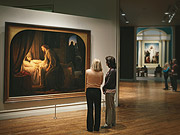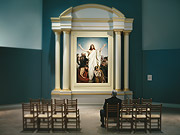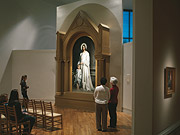“Carl Bloch: Reaching toward Heaven,” Ensign, Apr. 2011, 42–47
Carl Bloch: Reaching toward Heaven
Through May 7, 2011, Brigham Young University Museum of Art is hosting Carl Bloch: The Master’s Hand—an exhibit of Bloch’s paintings and etchings. Admission is free, but visitors must register for tickets—at CarlBloch.byu.edu.
Nine years in the making, the exhibit highlights four larger-than-life altarpieces of Christ from churches in Denmark and Sweden, and one former altarpiece. This is the first time they have been shown together.
In 1973 President Thomas S. Monson traveled to Frederiksborg Castle in Hillerod, Denmark, to see 23 of Carl Bloch’s paintings of the life of Christ. Dawn Pheysey, curator of this exhibit quotes President Monson as saying, “When I see a Carl Bloch painting, I feel … the spirit of Jesus and His ministry comes alive. I want to follow [His example], and, as a result, the depiction becomes a vibrant lesson of life.”1
Many Latter-day Saints feel the same. In Bloch’s own time, art critic Karl Madsen said of him that he “reached higher toward the great heaven of art” than anyone else. And Bloch said of his work, “God helps me … and then I’m calm.”
Latter-day Saints first saw 16 of Bloch’s paintings of the Savior in full color in the November 1962 Improvement Era. Today copies of Bloch’s paintings of Christ hang in LDS temples, meetinghouses, visitors’ centers, and also appear in Church magazines, manuals, and other materials.
“Bloch’s works illuminate the life and mission of the Savior with extraordinary power and insight,” says Campbell Gray, director of the BYU museum. “His paintings affirm Christ’s mission of salvation.”

The Doubting Thomas, 1881 (Far left) Courtesy of Ugerlose Kirke, Ugerlose, Denmark
This altarpiece is based on John 20:25, when Thomas said, “Except I shall see in his hands the print of the nails and put my finger into the print of the nails, and thrust my hand into his side, I will not believe.”
Christ Healing the Sick at Bethesda, 1883 (Background)
This former altarpiece depicts the scene described in the fifth chapter of John: “Jesus saith unto him, Rise, take up thy bed and walk” (John 5:8).
In September 2001, Brigham Young University acquired this painting from Bethesda Dansk Indre Mission in Copenhagen.

Christ in the Garden of Gethsemane, 1878–79 (Left) Courtesy of Sankt Hans Kirke, Odense, Denmark
Jay M. Todd wrote, “In Carl Bloch’s work we see the spirit of that which John the beloved wrote of Jesus:
‘In him was life; and the life was the light of men’(John 1:4).”2

The Daughter of Jairus, 1863 (Below) Courtesy of Statens Museum for Kunst, Copenhagen, © SMK Foto.
“When Jesus learned that Jairus’s daughter was dead, He said, “Be not afraid, only believe.” At her home, He said, “the damsel is not dead, but sleepeth.” Then he took the hand of the twelve-year-old girl and said, “Arise,” and she “arose” (see Mark 5:36, 39, 41–42).

Christus Consolator, 1881 (Above) Courtesy of Sofia Albertina Kyrka, Landskrona parish, Church of Sweden
“It was [Bloch’s] tender and sensitive soul that defined his ability to portray the plights of others with kind consideration,” says Dawn Pheysey, “and his deep-seated faith that enabled him to render compelling images of the Savior with devotion and love.”

Christ Blessing the Little Child, 1873 (Right) Courtesy of Sankt Nikolai Kirke, Holbaek, Denmark
Bloch’s “powerful use of light and shadow, … his accurate draftsmanship and the all but perfect structural qualities of his figures, … give a highly realistic quality to his paintings,” wrote Doyle Green.3

Courtesy Brigham Young University Museum of Art
Carl Heinrich Bloch
Self-portrait, 1886
-
Born in 1834 in Copenhagan, Denmark.
-
At 15, admitted to the Royal Danish Academy of Fine Arts.
-
At 25, received a travel scholarship to Rome, where he painted his first masterpiece—The Liberation of Prometheus.
-
At 31, commissioned to create 23 paintings for the King’s Oratory chapel at Frederiksborg Castle, which took him 14 years to complete.
-
At 34, married Alma Trepka while in Rome. The happy and prosperous couple had eight children.
-
Commissioned to paint eight large-scale altarpieces.
-
Died in 1890 leaving behind more than 250 paintings and 75 etchings.
Photography by Cody Bell